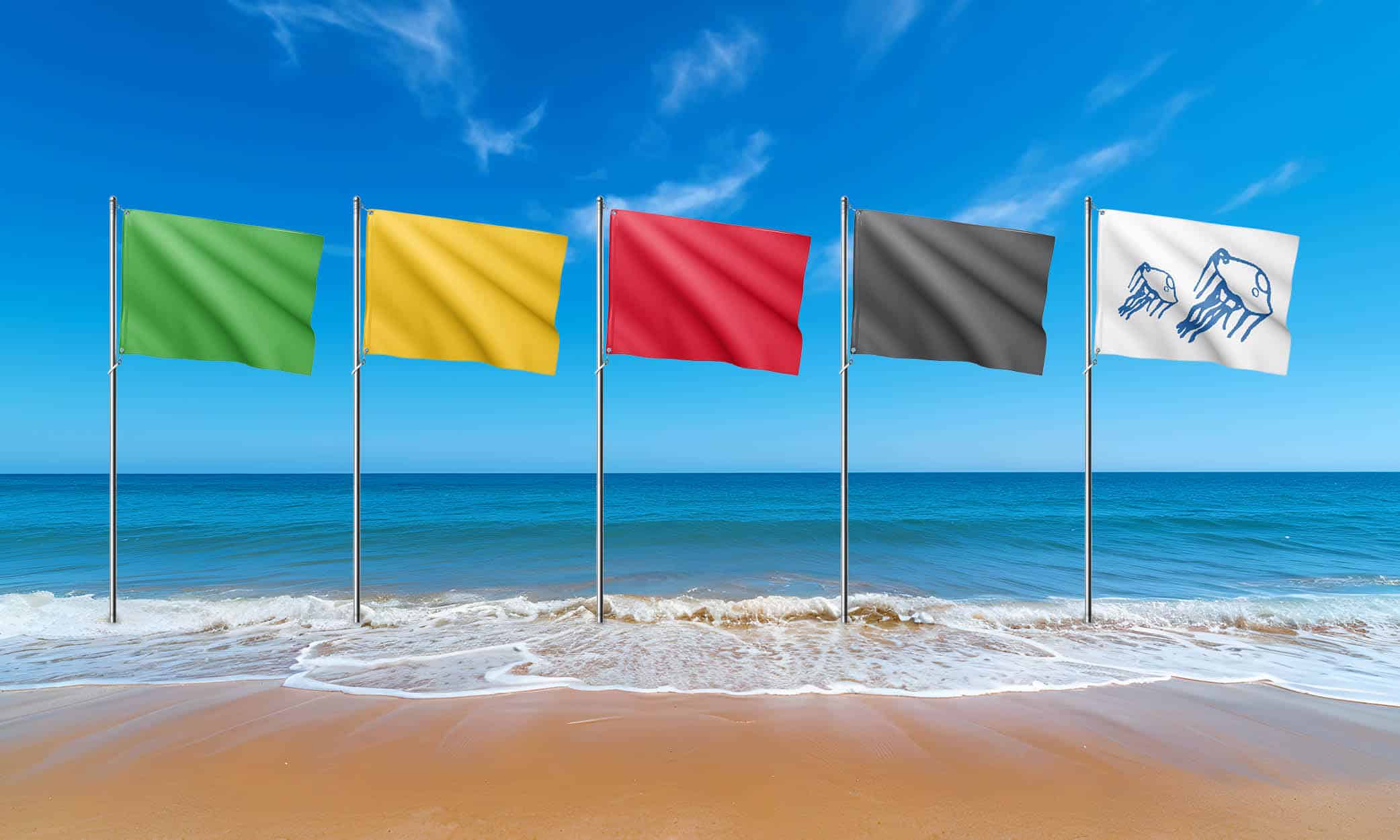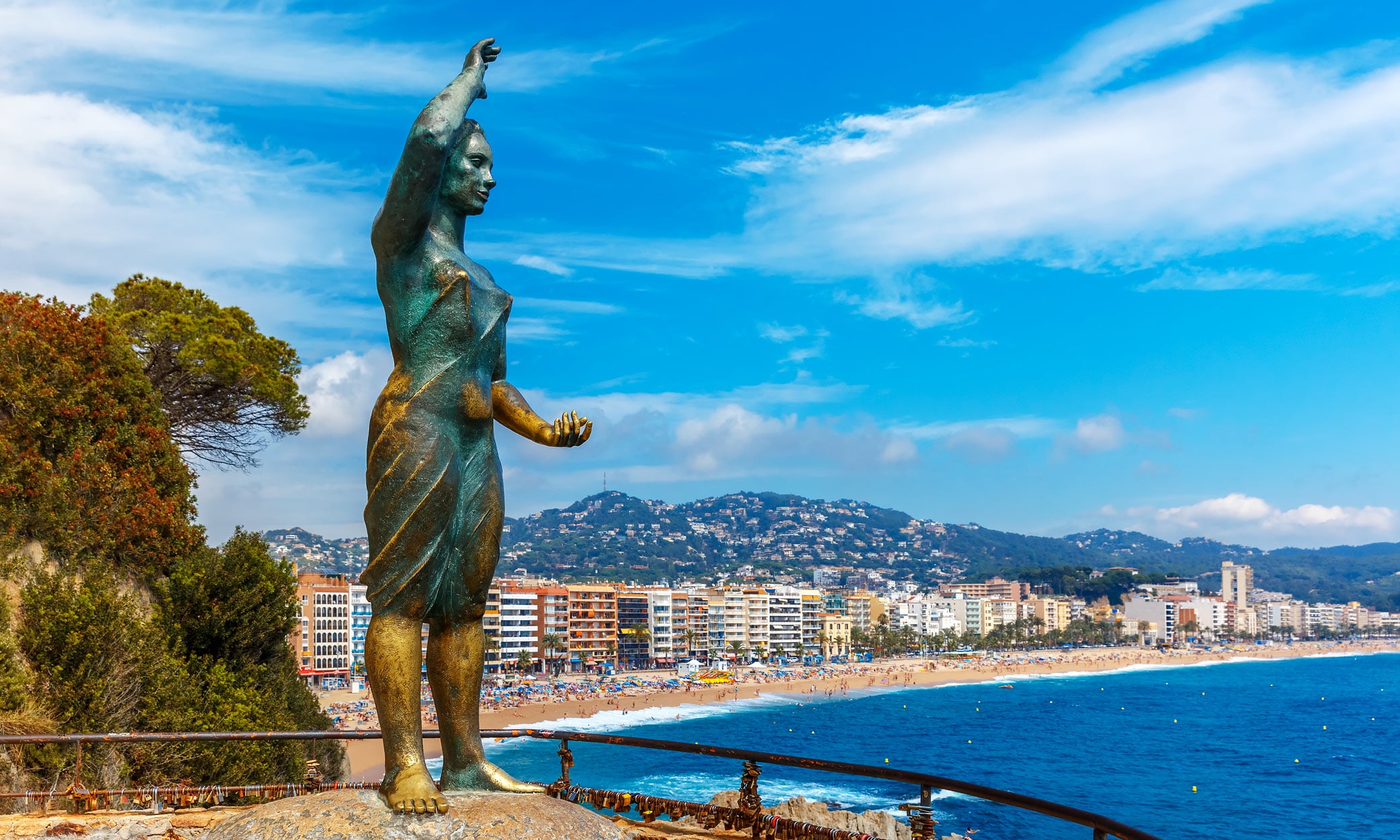Like so many other things in our daily lives here in Catalunya – from recycling to parking, to name just two examples – the flags used on Spanish beaches are colour-coded to let you know when and where it is safe to swim. The system is very simple, and it’s worth paying heed to whatever colour beach flag is on display. Not to do so would just be foolish!

Beach flag colour codes for safety
On most Costa Brava beaches, lifeguards are on duty from June through September, although exact dates can vary between municipalities. Typically, they’re on duty from around 10:00 until 19:00, but this can differ slightly from place to place.
With the lifeguards come the beach flags. If you’re not familiar with the colour-coded flag system used on Spanish beaches to indicate swimming conditions, here’s a quick guide:
🟢 A green flag means it’s safe to swim — go for it!
🟡 A yellow flag means swimming is allowed, but caution is advised. It’s best to stay close to the lifeguard zone.
🔴 A red flag means no swimming — better head to the xiringuito for a beer instead.
⚫ A black flag means the beach is unsafe due to sea or sand conditions. Luckily, these are rarely seen on La Costa Brava.
⚪ A white flag with jellyfish means they’re around today. The message is clear: another day for beers at the xiringuito!
Medusas
In general, jellyfish are not a big problem on Costa Brava beaches, but they do appear from time to time. The most common species found along these shores is, rather unimaginatively, called the Common Jellyfish. In both Catalan and Spanish, however, it’s known as a medusa.
If you remember your Greek mythology (or maybe just some movies!), Medusa was a winged part-human woman with poisonous snakes for hair — a bit like jellyfish tentacles. Lovely, right? In legend, anyone who looked Medusa in the eye would be turned to stone. The jellyfish version is far less dramatic… it’ll just sting you.
Actual jellyfish beach flags are rare. Lifeguards will usually raise a yellow flag if there are only a few jellyfish present. But occasionally, extreme weather — especially heat — can drive jellyfish from deeper waters into the shallows. If you do see a jellyfish flag, don’t ignore it. It’s there for a reason!

Blue Beach Flag
A Blue Flag represents something different. It’s an eco-label award for beaches that follow good practices in water quality, environmental management, safety and services, and environmental education.
As the introduction on the Global Blue Flag website explains:
“The iconic Blue Flag is one of the world’s most recognised voluntary awards for beaches, marinas, and sustainable tourism boats. In order to qualify for the Blue Flag, a series of stringent environmental, educational, safety, and accessibility criteria must be met and maintained.”
Staying with those Blue Flag beaches…
Did you know that Spain remains the world leader in the number of beaches awarded Blue Flags — and has held that title for several years now? In 2025, Spain received a total of 747 Blue Flags nationwide, keeping the top spot ahead of Greece, Turkey, and France.
Of those, 642 were awarded to beaches, with the rest going to port marinas and sustainable tourist boats. Within that grand total, 118 Blue Flags were awarded in Catalunya, and 28 of those are right here on the Costa Brava.
Among Spain’s leading Comunidades Autónomas, Valencia tops the list (with Alicante as the No. 1 province), followed by Andalusia, Galicia, and then Catalunya in fourth place.
Below is the complete list of Blue Flag beaches in the Costa Brava, grouped by municipality. And to make things even easier, we’ve also created a Map of Blue Flag Costa Brava Beaches for 2025!
Most of these beaches are located in the Baix Empordà. In addition to the beaches, Blue Flags were also awarded to the following port marinas:
• Llançà: Club Nàutic
• Port de la Selva: Club Nàutic
• Port Esportiu de Roses
• Estartit: Club Nàutic
• Aiguablava: Club Nàutic
• Palamós: Club Nàutic Costa Brava and Port Marina
• Platja d’Aro: Club Nàutic Port d’Aro
• Blanes: Club de Vela
List of Blue Flag Beaches in Costa Brava (2025):
Alt Empordà
• Llançà: Grifeu, Port de Llançà
• El Port de la Selva: Platja del Port de la Selva
• Castelló d’Empúries: Empuriabrava
Baix Empordà
• Torroella de Montgrí: Cala Montgó
• Palafrugell: Tamariu, Llafranc, Canadell
• Palamós: La Fosca
• Calonge i Sant Antoni: Es Monestri, Sant Antoni, Torre Valentina, Can Cristus – Ses Torretes
• Castell-Platja d’Aro: Cala Rovira, Platja Gran, Sa Conca
La Selva
• Sant Feliu de Guíxols: Sant Pol, Sant Feliu
• Tossa de Mar: Mar Menuda, Platja Gran
• Lloret de Mar: Cala Canyelles, Lloret, Sa Boadella, Santa Cristina, Fenals
Know before you go
For the most part, the platjas of the Baix Empordà are fantastic spots for swimming, sunbathing, lunch, and relaxing. But always check the beach flags before diving in — strong currents or unsafe conditions aren’t always visible to the untrained eye. Sadly, drownings still occur each year along the Catalan coast, often due to people ignoring safety warnings.
Whatever kind of beach you’re after, the Costa Brava has it all.
From small coves to wide beaches stretching several kilometres, there’s something for everyone. Whether you’re looking for a family-friendly beach, a lively spot with food and drinks, or a quiet, secluded naturist beach where you can strip to your birthday suit and go au naturale, the Costa Brava has you covered.
Some beaches even allow dogs during the summer, and while there aren’t many, the ones that do are well worth visiting. Outside the main tourist season, dogs can enjoy almost all Costa Brava beaches freely. Check out our Pets Article to find out which beaches are dog-friendly in 2025.
Need a few ideas? Have a look at our Top 10 Beaches of El Baix Empordà article. With so many stunning beaches across the Costa Brava, we had to narrow it down — this time we’ve focused just on the Baix Empordà. Some fantastic beaches didn’t even make the list! But don’t worry, we’re working on a follow-up piece featuring the best beaches of the Alt Empordà. Stay tuned.

By the way…
If you see a red and yellow flag, don’t be confused; it’s not a beach flag at all! That’s just the official flag of the Comunitat Autònoma de Catalunya and is the same one you’ll see flying outside Ajuntaments (Town Halls) around the region. It’s not the independentista flag, just the regular official one, and is called La Senyera. The independentista one is called the Estellada, but that’s a story for another day!








